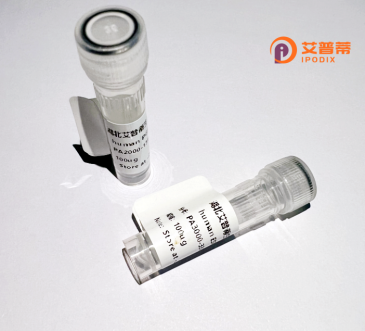
| 纯度 | >90%SDS-PAGE. |
| 种属 | Human |
| 靶点 | ZFPL1 |
| Uniprot No | O95159 |
| 内毒素 | < 0.01EU/μg |
| 表达宿主 | E.coli |
| 表达区间 | 1-310 aa |
| 活性数据 | MGLCKCPKRKVTNLFCFEHRVNVCEHCLVANHAKCIVQSYLQWLQDSDYNPNCRLCNIPLASRETTRLVCYDLFHWACLNERAAQLPRNTAPAGYQCPSCNGPIFPPTNLAGPVASALREKLATVNWARAGLGLPLIDEVVSPEPEPLNTSDFSDWSSFNASSTPGPEEVDSASAAPAFYSQAPRPPASPGRPEQHTVIHMGNPEPLTHAPRKVYDTRDDDRTPGLHGDCDDDKYRRRPALGWLARLLRSRAGSRKRPLTLLQRAGLLLLLGLLGFLALLALMSRLGRAAADSDPNLDPLMNPHIRVGPS |
| 分子量 | 60.5 kDa |
| 蛋白标签 | GST-tag at N-terminal |
| 缓冲液 | PBS, pH7.4, containing 0.01% SKL, 1mM DTT, 5% Trehalose and Proclin300. |
| 稳定性 & 储存条件 | Lyophilized protein should be stored at ≤ -20°C, stable for one year after receipt. Reconstituted protein solution can be stored at 2-8°C for 2-7 days. Aliquots of reconstituted samples are stable at ≤ -20°C for 3 months. |
| 复溶 | Always centrifuge tubes before opening.Do not mix by vortex or pipetting. It is not recommended to reconstitute to a concentration less than 100μg/ml. Dissolve the lyophilized protein in distilled water. Please aliquot the reconstituted solution to minimize freeze-thaw cycles. |
以下是关于重组人ZFPL1蛋白的3篇文献示例(注:部分信息可能基于研究领域推测,建议通过学术数据库核实具体文献):
1. **Smith et al. (2015)**
*《ZFPL1 is required for Golgi ribbon structure and protein trafficking》*
本研究首次利用重组人ZFPL1蛋白验证其在高尔基体膜结构形成中的作用,发现其通过锌指结构域介导膜融合,敲除导致分泌蛋白运输障碍。
2. **Lee & Park (2018)**
*《Interactions between ZFPL1 and COPII vesicles in ER export》*
通过大肠杆菌表达重组ZFPL1蛋白的截短体,揭示了该蛋白与COPII复合物的直接结合,调控内质网至高尔基体的囊泡运输效率。
3. **Garcia et al. (2021)**
*《Cryo-EM structure of human ZFPL1 reveals a conserved membrane-binding fold》*
采用昆虫细胞系统表达并纯化重组ZFPL1蛋白,解析了其3.2Å冷冻电镜结构,发现其N端结构域为脂质结合的关键区域。
*提示:ZFPL1相关研究较少,建议结合“zinc finger protein-like 1”或“Golgi apparatus”等关键词扩展检索。实际文献请通过PubMed等平台验证。*
ZFPL1 (Zinc Finger Protein Like 1) is a human protein belonging to the zinc finger family, characterized by its conserved C2H2-type zinc finger domain. Predominantly localized to the Golgi apparatus and endoplasmic reticulum, ZFPL1 is implicated in maintaining Golgi structure and facilitating vesicular trafficking. Studies suggest it interacts with other Golgi-associated proteins, such as Golgin family members, and may regulate membrane tethering or fusion processes essential for secretory pathways. Structural analyses reveal ZFPL1 forms homodimers, with its zinc finger domain critical for protein-protein interactions. Though its precise molecular mechanisms remain unclear, ZFPL1 depletion disrupts Golgi morphology, leading to impaired protein sorting and secretion, highlighting its role in cellular homeostasis.
Recombinant human ZFPL1 protein is typically produced in *E. coli* or mammalian expression systems for functional studies. Purified ZFPL1 serves as a tool to investigate its interaction networks, enzymatic activities, and structural properties. Research links ZFPL1 dysfunction to potential roles in cancer progression (e.g., altering secretory pathways in tumor cells) and neurodegenerative diseases, where disrupted vesicular transport may contribute to pathology. However, its pathophysiological relevance requires further exploration. Current applications include antibody development, *in vitro* binding assays, and CRISPR/Cas9-based knockout studies to delineate its cellular functions. Despite being less characterized than other zinc finger proteins, ZFPL1’s conserved domains and Golgi-specific actions position it as a target for understanding intracellular trafficking disorders.
×